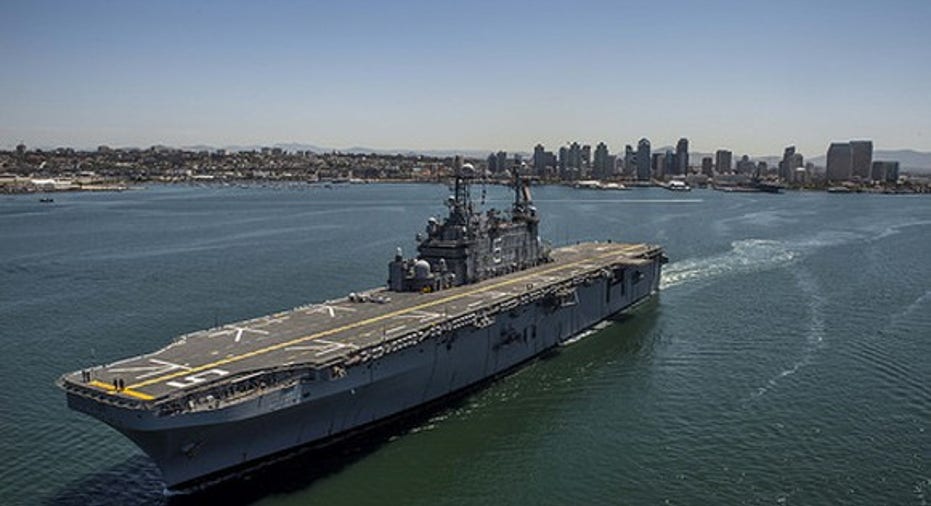Huntington Ingalls Lands a Big Contract to Build a Small Aircraft Carrier

Huntington Ingalls-built "LHA 8" may look a lot like its predecessor, the USS Peleliu (LHA 5). Image source: U.S. Navy.
Fiscal quarters are funny things -- at least at the Pentagon.
Every three months -- Sept. 30, Dec. 31, March 31, and most recently, June 30 -- another fiscal quarter draws to a close. And when it does, there's a mad dash at the Department of Defense to shovel money out the door and quickly spend all the funds that Congress has allotted for the quarter before it's too late. Otherwise, someone might decide the DoD didn't actually need all that money, and cut funding next time.
And so it was that the final day of the June fiscal quarter last week saw the Pentagon award not one, not two, but $10.89 billion dollars in new contract awards-- including a big one for Huntington Ingalls .
A return to form
Specifically, the Pentagon awarded Huntington Ingalls $272.5 million for work on "the planning, advanced engineering, and procurement of long lead time material in support of one amphibious assault ship (LHA 8)."
The last two LHA vessels, the USS America (LHA 6) and the USS Tripoli (LHA 7, currently under construction), were both true mini-aircraft carriers "optimized for aviation capability." In contrast to those, the Navy says theLHA 8 (which has yet to be named, but which will become the lead ship of a new class) will return to the format of past LHA-class vessels and "reincorporate a well deck to increase operational flexibility."
Thus, while describedprimarily as a large-deck helicopter assault ship, LHA 8's well deck will make it easier to disembark and embark Marine Corps landing craft aboard the mother ship.
Big money for small aircraft carriers
And in building LHA 8, Huntington Ingalls will landsome serious cash. Since 1966, Huntington Ingalls has built, or has been building, 15 LPH-, LHD-, and LHA-class amphibious assault ships for the Navy. The LHA 8 contract will raise that number to 16, and add billions to Huntington's revenue stream.
The initial contract giving Huntington Ingalls the go-ahead to begin work on the craft may be worth only $272.5 million, but by the time the ship is completed, it's expected to costthe Navy as much as $3.1 billion. Thus, this single ship will be worth nearly half a year's revenues to the contractor.
How much is that worth?
Last quarter, Huntington Ingalls CEO Mike Petters highlighted Ingalls Shipbuilding's strong margin performance, and 25% surge in revenues, as one reason Huntington Ingalls stock strongly outperformed estimates in Q1. Currently responsible for less than one-third of the company's total revenue, Ingalls produces roughly half of the company's profits, earning an 18% operating profit margin on its $2.3 billion in annual revenue.
Now, Petters has been quite clear in warning that operating margins of this level are not sustainable, and that Huntington Ingalls' margins are due to turn down eventually. The longer that that prospect can be put off, however, the better for the company's profits. Thus, $3.1 billion in high-margin revenues from the LHA 8 contract is very good news for Huntington Ingalls shareholders indeed. Ultimately, it could yield profits of nearly $560 million -- more than all Ingalls produced last year.
Not bad for a single ship, even if it is a (small) aircraft carrier.
The article Huntington Ingalls Lands a Big Contract to Build a Small Aircraft Carrier originally appeared on Fool.com.
Rich Smithdoes not own shares of, nor is he short, any company named above. You can find him onMotley Fool CAPS, publicly pontificating under the handleTMFDitty, where he's currently ranked No. 306 out of more than 75,000 rated members.The Motley Fool has no position in any of the stocks mentioned. Try any of our Foolish newsletter services free for 30 days. We Fools may not all hold the same opinions, but we all believe that considering a diverse range of insights makes us better investors. The Motley Fool has a disclosure policy.
Copyright 1995 - 2016 The Motley Fool, LLC. All rights reserved. The Motley Fool has a disclosure policy.